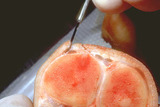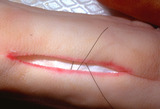The Health Education Assets Library (HEAL) is a collection of over 22,000 freely available digital materials for health sciences education. The collection is now housed at the University of Utah J. Willard Marriott Digital Library.
TO
Filters: Collection: ehsl_heal
| Title | Description | Subject | Collection | ||
|---|---|---|---|---|---|
| 76 |
 |
Exaggerated insect bite reaction, possibly secondary to chigger bites | Exaggerated insect bite reaction. Other lesions were red plaques that measured 1.5 to 2.0 cm, and were very pruritic. | Knowledge Weavers Dermatology | |
| 77 |
 |
Excising with scalpel | When excising the scalpel should be held as if holding a pencil. A puncture should be made at one end of the ellipse. | Surgical Methods | Knowledge Weavers Dermatology |
| 78 |
 |
Excising with scalpel | A partial or full thickness cut is made, and the blade should be kept perpendicular to the skin or angled outward. | Surgical Methods | Knowledge Weavers Dermatology |
| 79 |
 |
Excision procedure | Demonstrates the same V. Summary) | Knowledge Weavers Dermatology | |
| 80 |
 |
Excision procedure | The following slides are a brief review of the excision procedure. The scalpel is angled outward away from the wound edge to ensure that the wound edges are beveled at about 45 o. | Surgical Methods | Knowledge Weavers Dermatology |
| 81 |
 |
Excision procedure | This suture is tightened by crossing the non-dominant (left) and over the dominant (right) hand. This same sequence is continued until four loops have been thrown and then the suture is cut leaving ends approximately .5 cm long. | Knowledge Weavers Dermatology | |
| 82 |
 |
Excision procedure | The central specimen is then removed ensuring that there is same thickness throughout the specimen. | Surgical Methods | Knowledge Weavers Dermatology |
| 83 |
 |
Excision procedure | This demonstrates the 45 degree angle in cross-section. | Knowledge Weavers Dermatology | |
| 84 |
 |
Excision procedure | Deep dermal suture is placed as far away from the wound edge as possible. It's initiated on the non-dominant (left) side, and final exit is on the dominant (right) side as shown here. | Knowledge Weavers Dermatology | |
| 85 |
 |
Excision procedure | The wound that has been created in cross-section; note the beveling of the wound edges. | Knowledge Weavers Dermatology | |
| 86 |
 |
Excision procedure | This demonstrates the deep dermal suture ends that are exiting from the wound, and the order is crucial: loop-short-long. The long end is the needle bearing end. | Knowledge Weavers Dermatology | |
| 87 |
 |
Excision procedure | The suture is wrapped twice around the needle holder and the short arm of the suture is then grasped, and | Knowledge Weavers Dermatology | |
| 88 |
 |
Excision procedure | This demonstrates the 45 o angle in cross-section as one cuts through the dermis. | Surgical Methods | Knowledge Weavers Dermatology |
| 89 |
 |
Excision procedure | This demonstrates placement of the deep dermal suture that is secured to the underside of the dermis as far away from the wound edge as possible. | Knowledge Weavers Dermatology | |
| 90 |
 |
Excision procedure | Undermining on the opposite side of the wound. | Surgical Methods | Knowledge Weavers Dermatology |
| 91 |
 |
Excision procedure | Undermining is achieved by using scalpel or scissors to free the dermis from the fibrous septae that connect it to the underlying fascia. One undermines the wound until the wound edges pull together readily. | Surgical Methods | Knowledge Weavers Dermatology |
| 92 |
 |
Excision: knot tying | The needle holder is placed on the inside the long arm (needle bearing end) of the V as shown. Before beginning to tie the knot, insure that the two ends of the suture come out the same side of the loop, and that the order is: loop, short (non-needle bearing) end, long (needle bearing) end. | Knowledge Weavers Dermatology | |
| 93 |
 |
Excision: suturing | The double loop is tightened by pulling the hands into their natural position, but the knot cannot be adequately tightened by pulling in that direction; the knot must be tightened by pulling the suture ends along the length (long axis) of the wound. (This is shown in the following slide) | Knowledge Weavers Dermatology | |
| 94 |
 |
Excision: suturing | AVis formed as the deep dermal suture exits from the wound, and the suture is pulled so that the short (non-needle bearing end) is about 2 cm long. Both strands of suture should come out on the same side of the loop, and the order must be: loop, short end (non-needle bearing), long end (needle bea... | Knowledge Weavers Dermatology | |
| 95 |
 |
Excision: suturing | The needle holder is then placed inside the long arm of the V, and a single loop is thrown around the needle holder. The short arm of the suture is then grasped. | Knowledge Weavers Dermatology | |
| 96 |
 |
Excision: suturing | A single loop is thrown around the needle holder. The short arm of the suture is then grasped. | Knowledge Weavers Dermatology | |
| 97 |
 |
Excision: suturing | Two loops are placed around the needle holder to initiate the first throw. The short end of the suture is then grasped, and the hand holding the long(needle bearing) end of the suture crosses over the hand with the needle holder. | Knowledge Weavers Dermatology | |
| 98 |
 |
Excision: suturing | The suture is tightened by pulling the suture with the hands ending in natural position. The knot tying procedures previously shown are done twice more until the four throws have been placed. Suture is then cut just above the knot. Deep dermals are placed roughly every cm along the under-surface (ba... | Knowledge Weavers Dermatology | |
| 99 |
 |
Excision: suturing | The loops must be tightened by pulling and tightening along the long axis of the wound. | Knowledge Weavers Dermatology | |
| 100 |
 |
Excision: suturing | The non-dominant (left) hand crosses over the dominant (right) hand on the second throw. | Knowledge Weavers Dermatology |
